June, 2013
now browsing by month
Extinct Birds the Lenape Knew
The two birds shown below were well known to the Lenape people. Now they are both extinct. Only the Lenape name for the Passenger Pigeon is remembered. As we were forced westward we moved out of the area where the Carolina Parakeets were and their name became lost to us.
We are showing these two illustrations by the painter John James Audubon to remind those who view these pages how fragile the other inhabitants of our world can be, and how we all need to take care of our “Mother Earth.”
Click on the Lenape name to hear the bird’s name as pronounced by Lenape speaker Nora Thompson Dean.
 |
Amimi
Passenger Pigeon (Ectopistes migratorius) NOW EXTINCT !! |
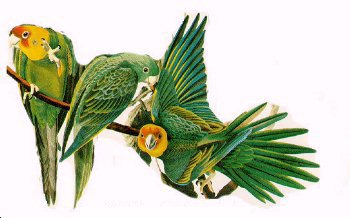 Carolina Parakeets |
The Passenger Pigeon was one of the most abundant bird species on earth not long ago. Lenape elder Ohëlëmitakwsi (James Thompson) told how, when he was a boy in Indian Territory (now Oklahoma) in the 1870s, he saw a flock fly over, and it took almost twenty minutes for them to pass.
They were driven to extinction by uncontrolled commercial hunting for the settlers. The pigeons’ migration and nesting made them easy to hunt in large numbers. By 1850, several thousand people were employed in the passenger pigeon industry. In New York, one operation alone processed 18,000 pigeons each day in 1855.
In 1914 the last Passenger Pigeon died at the Cincinnati Zoo. Before their extermination, a single flock of passenger pigeons could have two billion birds or more, and there were many flocks in the United States.
The Carolina Parakeet was America’s only native parrot. They lived over much of the United States east of the great plains. Their numbers began to decrease in the early 1800s. As the settlers began to farm more land, the Parakeets would flock to the fields and orchards, destroying the crops. The settlers could easily kill the birds as when one of their flock was shot, the others would fly around their fallen friend instead of flying away for safety. It was because of this behavior that the entire flock could easily be destroyed.
The birds were also shot for their colorful feathers which were sold to decorate women’s hats. It is also thought that the destruction of their habitat may have contributed to their decline. By the 1890s, Carolina Parakeets were very rare.
The last known pair of Carolina Parakeets had lived in the Cincinnati Zoo for thirty-five years, and they were named “Incas” and “Lady Jane.” In the summer of 1917, Lady Jane died, leaving Incas spiritless and mournful, and alone, the last of his kind, he “died of grief” on 21 February 1918.
Lenape Names for Birds
On this page are photos and the Lenape names for some common birds. Click on the Lenape name to hear the bird’s name as pronounced by Lenape speaker Nora Thompson Dean. For those images with a speaker icon at the bottom, you may also click on the bird’s photo to hear its call.
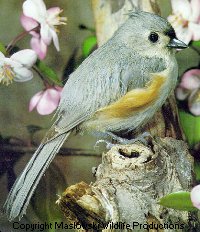 |
Tànktiyas
Tufted Titmouse (Parus bicolor) |
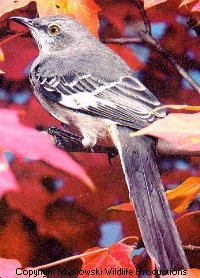 |
Tàskëmus
Mockingbird (Mimus polyglottos) |
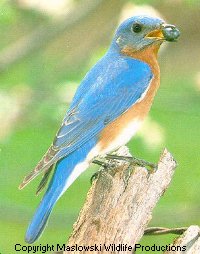 |
Chihopèkëlis
Eastern Bluebird (Sialia sialis) |
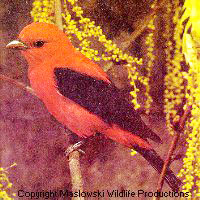 |
Wetënteis
Scarlet Tanager (Pirange olivacea) |
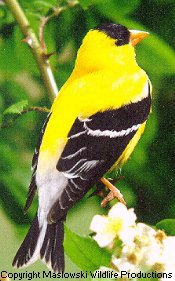 |
Wisawtayas
American Goldfinch (Carduelis tristis) |
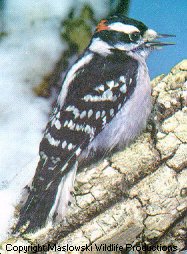 |
Tihtës
Downy Woodpecker (Picoides pubescens) |
 |
Sënihële
Sparrow Hawk or American Kestrel (Falco sparverius) |
 |
Hinutët
Wren (Picoides pubescens) |
 |
Chiskukus
Robin (Turdus migratorius) |
 |
Lelèmpëlis
Ruby-Throated Hummingbird (Archilochus colubris) |
These copyrighted photographs are used courtesy of Maslowski Wildlife Productions. We would like to thank them for giving us permission to use these fine photographs.
See also: Extinct Birds the Lenape Knew
Common Words and Phrases, Page 2
Click the Lenape word to hear it pronounced.
| Lenape | English |
|---|---|
| PHRASES | |
| Wanìshi | Thank you |
| Kulamàlsi hàch? | Are you well? |
| nulamàlsi | I am well |
| mpalsi | I am sick |
| nëwikwihëla | I am tired |
| ntakòhchi | I am cold |
| mënihi | Give me a drink |
| mushhakòt | the sky is clear |
| kùmhòkòt | the sky is cloudy |
| pèthakhòn | it is thundering |
| kshàxën | it is windy |
| wine | it is snowing |
| BIRDS AND ANIMALS | |
| ahas | crow |
| òkwës | fox |
| chinkwe | bobcat |
| pukwès | mouse |
| sànkwe | weasel |
| tëme | wolf |
| xanikw | squirrel |
| chulëns | bird |
| ntalëmuns | my pet |
| MORE NUMBERS | |
| kwëtash | six |
| nishash | seven |
| xash | eight |
| pèshkunk | nine |
| tèlën | ten |
| kwëtash, nishash, xash, pèshkunk, tèlën | six thru ten |
| Sounds: a – father, à – up, e – gate, è – get, ë – above, i – me, ì – pick, o – open, ò – for, u – boot, ù – look, x – nacht (as in German). | |
Common Words and Phrases
Click the Lenape word to hear it pronounced.
| Lenape | English |
|---|---|
Hè
|
Hello! (or) Hi! |
Làpìch knewël
|
I will see you again. (Goodbye) |
tëmike
|
Come in! (or) Go in! |
lëmatahpi
|
Sit down! |
wëntaxa
|
Come here! |
mitsi
|
Eat! (speaking to one person) |
mitsikw
|
You eat! (speaking to two or more) |
mitsitàm
|
Let’s eat! |
tukihëla
|
Wake up! |
taktani
|
I don’t know |
nkatupwi
|
I am hungry |
nkatusëmwi
|
I am thirsty |
nkatungòm
|
I am sleepy |
mili kàpi
|
Give me some coffee |
Lënape nàn
|
He (or she) is a Lenape |
Lënape hàch nàn
|
Is he a Lenape? |
ktalënixsi hàch
|
Do you speak Lenape? |
kèxiti
|
a little |
kèku hàch lakeyu
|
What tribe (or nationality) is he? |
wëli kishku
|
It is a good day |
lëlëwàxën
|
There is a breeze |
shëlànde
|
It is a hot day |
sukëlan
|
It is raining |
kwëti
|
one |
nisha
|
two |
naxa
|
three |
newa
|
four |
palenàxk
|
five |
kwëti,nisha, naxa, newa, palenàxk
|
one, two, three, four, five |
| PHRASES | |
Wanìshi
|
Thank you |
Kulamàlsi hàch?
|
Are you well? |
nulamàlsi
|
I am well |
mpalsi
|
I am sick |
nëwikwihëla
|
I am tired |
ntakòhchi
|
I am cold |
mënihi
|
Give me a drink |
mushhakòt
|
the sky is clear |
kùmhòkòt
|
the sky is cloudy |
pèthakhòn
|
it is thundering |
kshàxën
|
it is windy |
wine
|
it is snowing |
| BIRDS AND ANIMALS | |
ahas
|
crow |
òkwës
|
fox |
chinkwe
|
bobcat |
pukwès
|
mouse |
sànkwe
|
weasel |
tëme
|
wolf |
xanikw
|
squirrel |
chulëns
|
bird |
ntalëmuns
|
my pet |
| MORE NUMBERS | |
kwëtash
|
six |
nishash
|
seven |
xash
|
eight |
pèshkunk
|
nine |
tèlën
|
ten |
kwëtash, nishash, xash, pèshkunk, tèlën
|
six thru ten |
| Sounds: a – father, à – up, e – gate, è – get, ë – above, i – me, ì – pick, o – open, ò – for, u – boot, ù – look, x – nacht (as in German). | |
The Last Removal
A painting by Lenape artist Jacob Parks
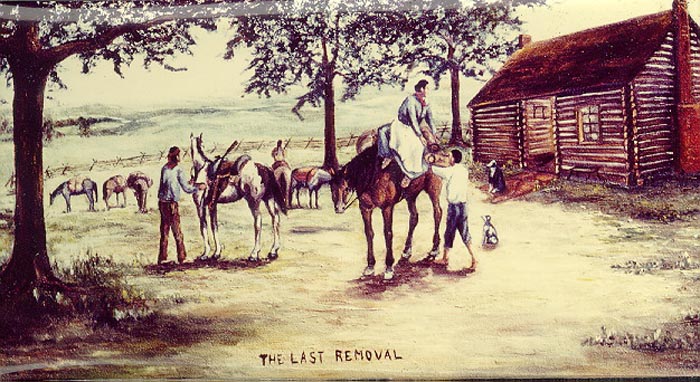
- THE LAST REMOVAL — A painting by Lenape artist Jacob Parks (1890-1949), which depicts a Lenape family leaving their home on their reservation in Kansas in 1867. This area had been their home for over thirty-five years, and now the government told them they had to move to Indian Territory (now Oklahoma).
The Walking Purchase
In Lenape history there is the story of the “Walking Purchase” which took place in 1737. William Penn had always dealt fairly with the Lenape, but after he returned to England his sons and other agents began to sell land to pay their creditors, and these were lands which were still owned by the Lenape.
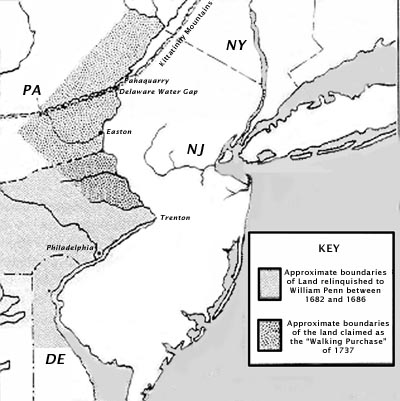 In order to convince the Lenape to part with the land, the Penns falsely represented an old, incomplete, unsigned draft of a deed as a legal contract. They told the Lenape that their ancestors some fifty years before had signed this document which stated that the land to be deeded to the Penns was as much as could be covered in a day-and-a-half’s walk.
In order to convince the Lenape to part with the land, the Penns falsely represented an old, incomplete, unsigned draft of a deed as a legal contract. They told the Lenape that their ancestors some fifty years before had signed this document which stated that the land to be deeded to the Penns was as much as could be covered in a day-and-a-half’s walk.
Believing that their forefathers had made such an agreement the Lenape leaders agreed to let the Penns have this area walked off. They thought the whites would take a leisurely walk down an Indian path along the Delaware River. Instead, the Penns hired three of the fastest runners, and had a straight path cleared. Only one of the “walkers” was able to complete the “walk,” but he went fifty-five miles.
And so by means of a false deed, and use of runners, the Penns acquired 1200 square miles of Lenape land in Pennsylvania, an area about the size of Rhode Island! The Lenape people complained about the way the “walk” had been done. Lenape chief Lappawinsoe expressed the frustration and dissatisfaction of the Lenape when he said:
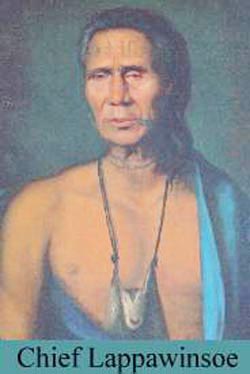 [the white runners] should have walkt along by the River Delaware or the next Indian path to it… should have walkt for a few Miles and then have sat down and smoakt a Pipe, and now and then have shot a Squirrel, and not have kept up the Run, Run all day.
[the white runners] should have walkt along by the River Delaware or the next Indian path to it… should have walkt for a few Miles and then have sat down and smoakt a Pipe, and now and then have shot a Squirrel, and not have kept up the Run, Run all day.
Nonetheless, the Lenape felt honor-bound to fulfill what they thought their ancestors had agreed to, and thus began their movement westward. The Lenape were given place after place. Each time it was promised by the government that it would be their permanent home, only to have to move again. Their trek, which lasted 130 years, finally brought them to what was known as Indian Territory, now Oklahoma.
Lenape Men’s Clothing — The Bandolier
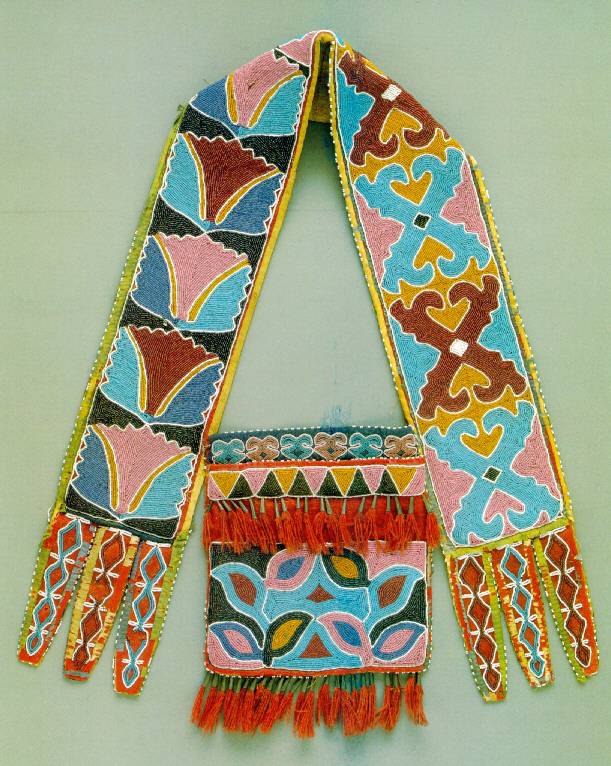
- One item worn by Delaware men was the Bandolier Bag. This had a wide, fully beaded shoulder strap 2 to a beaded bag. A number of these are now in museums as they were a favorite of collectors.
Lenape Pottery

- Pottery — The Lenape made cooking pots and other vessels out of clay. In this photograph the small pot on its side is the normal size cooking vessel. The large pot holds about twenty gallons and may have been used for some type of ceremonial event.
- Photgraph courtesy of Herbert C. Kraft

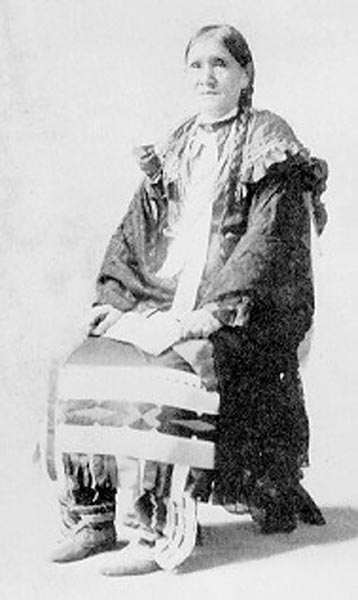
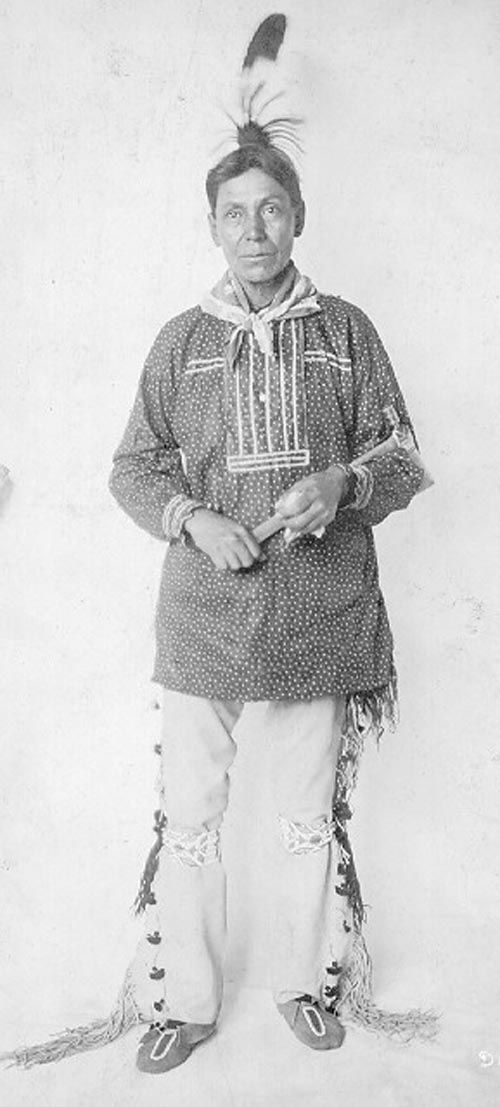
 D5 Creation
D5 Creation